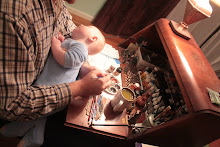So one of the issues with have a 3d printer is layer lines. The printer makes models by building layers of plastic, the size of which depends on printer type and printing settings. For a printer like the Ender 3, layer lines can get under a mm in height, which is small enough that you can not see them from any sort of distance, but you can see them when blown up on the screen, and can feel them a bit with your finger (human fingertips can apparently feel as small as 13nm differences in height).
So reducing layer lines is something that is worth looking in to a bit, and to that end I produce a small sample, which I treated in various ways to see how it was altered. I made a test piece with five surfaces, and then sprayed that with a layer of cream spray paint to see how it would look. I went another step and washed with a coat of Games Workshop's Nuln Oil to see how the finish was for a wash, since I use washes a lot with my figures.
 |
| Initial 3d surface print test with filing and filling |
Surfaces are:
1. Raw out of the printer
2. Filed
3. Filed and covered with black gesso
4. Filed and covered with Future
5. Filed and covered with PVA
 |
| Sprayed 3d print surface test cream white |
 |
| Painted with Nuln Oil wash |
Also evident are the changing conditions locally, since you can see that two of the three pictures are slightly orange from smoky air. It was actually clean enough to breath for that middle stage! When of course I was wearing a mask anyway...


5 comments:
I have no idea about how hard that plastic is but you could try using a very fine sandpaper (at least 800 grit) or try using steel wool. These days the best source of steel wool, in different grades, is Home Depot or Lowe’s. Anything from the grocery store will likely have soap in it.
I wouldn’t of thought that smoke could produce such a color, might have to rethink my own habits of when I prime and such.
I hope your experiment will prove useful as you get the 3D printer up and running. 😀
Burning a million acres of forest and grassland does tend to put a pall over things...
And good idea with the fine grit and steel wool Heisler, I will have to run another test.
Just hit me that you are in California and you guys are suffering from massive fires right? Climate change sucks ... hope you and your family are staying safe.
FourEyedMonster, yes, massive massive fires, but other than ruining the sky here, little local effect. Wife's cousins were displaced for a while, but lucky for them, no serious damage to their property.
Post a Comment